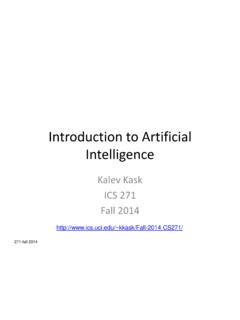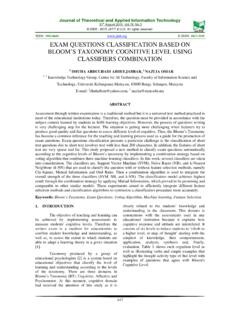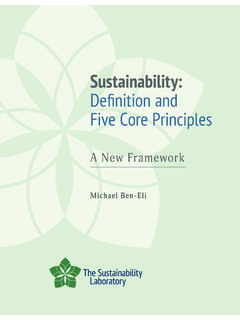Transcription of Educational Benefits of Music in an Inclusive Classroom
1 Educational Benefits of Music in an Inclusive Classroom Susan Sze, Niagara University, New York 14109 Sanna Yu, York Region District School Board, Ontario, Canada L4G 3H2 ABSTRACT The purpose of this study is to highlight literature concerning the effects of Music therapy on children with disabilities. The paper is organized in the following sections: (1) background of Music and children with disabilities, (2) the aims of Music therapy, (3) main contributions to cognitive, biopsychosocial development of children with disabilities, (4) implications for learning, and (5) implications for using Music to accommodate children with disabilities in an Inclusive Classroom . Background Music therapy is considered a related service modality in special education (IDEA, 1997). Music therapy can play an important role in special education because many students with disabilities need special instructional treatment.
2 Music is an ancient method for healing. It neutralizes negative feelings, increases stress tolerance level and harmonizes inner peace. The use of Music therapy can help people who are crippled by varies cognitive and biopsychosocial problems. It can also help to improve the quality of life for people with disabilities of various kinds. The IDEA (Individual with Disabilities Act) requires schools to provide related services and equipment for a student with a disability to ensure a free and appropriate public education. The reauthorization of IDEA (1997) mandates related services to be included into the Individual Education Program (IEP). In 2001, with passage of the No Child Left Behind Act (NCLB), the Department of Education is embracing evidence based research in order to improve the effectiveness of Educational intervention and in turn, academic achievement.
3 Regular education and special education teachers are given increased responsibilities for students with disabilities in their classrooms. Recent research indicates that Music therapy has a positive impact on students cognitive development. Aims The purpose of the study is to review literature concerning the effects of Music on students with disabilities. Music has become a powerful tool for students and teachers in many Inclusive classrooms. Music can facilitate inclusion of students with disabilities by making previously difficult or impossible tasks feasible. During the past decade, there has been a steady growth in the research base on the impact of Music to children with disabilities. A vast majority of the research has mainly focused on Music and medicine (Pratt, 1991; Chaquico, 1995; & Weinberger, 2000), Music therapy (Pelliten, 2000), Music as the basis for learning (Collett, 1992), usefulness of expressive arts ( Dixon & Chalmers, 1990 ), usefulness of Music to treat students with emotional and behavioral disorders (Houchens, 1983; Shennum, 1987; Gfeller, 1989, & King, 1994).
4 Very few studies provided a comprehensive view of some disability categories such as autism (Staum, ; & Stambough, 1996), mental retardation (MR) or cognitive delays, attention deficit disorders (ADHD), learning disabilities (LD) and physical and other health impairments (POHI). The current review builds on previous efforts to examine research on the effects of Music therapy to children with disabilities. Main Contribution Students with disabilities arrive daily in Music classes from kindergarten through high school. Effective integration of Music in the content areas creates a learning environment that makes all children want to learn. Collett (1992) reported a successful Music integrated curriculum which works well with bilingual and special education students. Music integration provide children with concrete, hands-on experiences that are essential to developing each child s ability to reason, think, solve problems, analyze, evaluate, and to enhancing creativity (Houchens, 1983).
5 Several studies have investigated the effects of Music therapy on children with cognitive disabilities. Straum ( ) suggested the use of Music to assist students with autism disorder in the areas of social and language development. Autistic children have eliminated their monotonic speech by singing songs composed to match the rhythm, stress, flow and inflection of the sentence followed by a gradual fading of the musical cues. The author also argues that Music can be used as a tool to encourage human development in cognitive, learning, perceptual, motor, social and emotional development. In a related study, Stambough (1996) conducted an action research at a Music camp to 37 campers ages from 9-45, each suffers varies degree of a genetic condition called Williams Syndrome, which leads to cognitive impairment.
6 She found that several strategies and techniques, combined with a great deal of patience, helped to accommodate the special needs of the students. Others researchers suggested steps for facilitating the integration of students with emotional or behavioral disorders into the regular Music Classroom . Results gathered from King & Schwabenlender (1994) reported various supportive strategies for promoting emotional well-being in children from a diverse background. Allow children to be expressive provides them with a sense of empowerment (Dixon & Chalmers, 1990). Implications Special education teachers have used Music to alter mood and assess emotional problems. Music allows the individual to invent emotions. Music is viewed as an integral part of all children s lives. Children enjoy listening to Music , singing, and humming.
7 Music may effectively enhance the ability to cope with stress. The author suggested that Music be found in both Music classes and regular education classrooms. She found that integrating literature with musical content helped to bring books alive and that musical classrooms encouraged children to relate and participate in the activities (Giles, Cogan, & Cox, 1991). However, very few studies provided a comprehensive view of some disability categories such as autism (Staum, ; & Stambough, 1996), mental retardation (MR) or cognitive delays, attention deficit disorders (ADHD), learning disabilities (LD) and physical and other health impairments (POHI). Below is a list of practical, relevant, and evidence based strategies teachers can use to help students with varies disabilities through Music . Speech and Language Impairments Music is more than a leisure activity.
8 It is more than verbal counseling. It is a sophisticated cognitive, linguistic, social and psychological treatment. Music provides a form of compensation for those with language impairments as well as a means of facilitating language development. 1. Find a piece of Music enjoyable to the student. 2. Encourage student to participate in the musical activities. 3. Have student verbally identify an instrument by name before he or she can play it. 4. Learn words and articulate particular phonemes through singing songs. 5. Create non-judgmental and nonverbal activities to help make student feels comfortable. 6. Create activities where any vocal sound is accepted as a creative part of the improvised Music . 7. Incorporated vocal sounds that are spontaneously emitted and that are elicited from the Music making. Orthopedics and Health Impairments Music affects heart beat, pulse rate, and skin responses (Hodges, 1980).
9 1. Place an instrument at a strategically placed distance to increase hands or arms movement. 2. Swing a mallet to strike a drum to help increase the range of motion. 3. Have student hold a musical instrument may help the development of fine motor coordination. 4. Vary the intensity of clapping, jumping, stamping, pounding, swinging, and snapping, etc. according to the severity of the disability. 5. Use slow and gentle Music to increase flexibility and to decrease hyper tense muscular contractions. Cognitive Disabilities Research in neurological functioning supports the association between Music and cognitive development. Music organizes sounds and silences in a flow of time. It creates expectations and are then satisfied. It raises a question and solves it. 1. Use mnemonic devices for remembering sequences (the alphabet song).
10 2. Use categorical structures to differentiate (animal farm, color, etc.). 3. Connect sound with a concept (a cow makes a moo sound ). Attention Deficit /Hyperactive Disorders and Learning Disabilities Music focuses on accuracy and attention. Learning how to play an instrument can improve attention, concentration, impulse control, social functioning, self-esteem, self-expression, motivation and memory. 1. Connect a particular vocal sound with a particular body movement. 2. Provide more than one neural pathway by using multi-sensory channels. 3. Use visual, auditory and kinesthetic (striking a drum, clapping hands). 4. Use the inherent structure in songs to reinforce a sense of internal order. 5. Use rhythm, steady pulse, and basic beat of Music as a model to help student to experience order, sequence, and a sense of consistency.


















